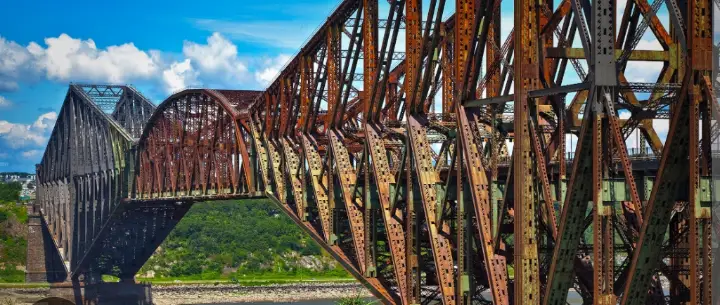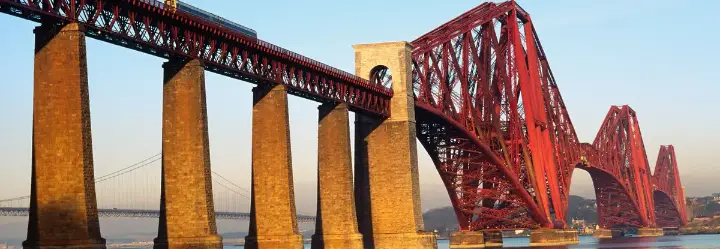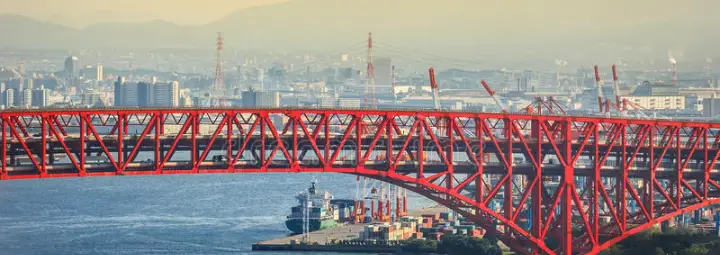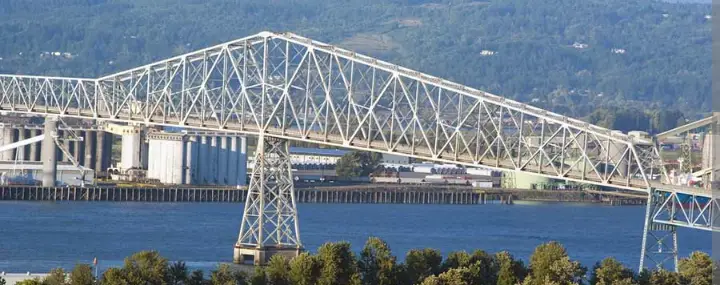When we think of bridges, we often envision suspension or beam structures that span across bodies of water. However, there’s another type of bridge that’s equally impressive and unique in its design: the cantilever bridge. Cantilever bridges are not only aesthetically pleasing but also structurally sound, with a number of advantages over other types of bridges. In this article, we’ll explore what makes a cantilever bridge so special and highlight some famous examples of cantilever bridges from around the world. So buckle up and get ready to learn about some amazing feats of engineering.
What is a Cantilever Bridge?
A cantilever bridge is a type of bridge that uses cantilevers – structures that project horizontally into space and are supported only on one end – to support the weight of the deck. The basic design consists of two main arms or beams, each projecting out from opposite sides of a central tower.
One of the key features of this type of structure is its ability to span long distances without requiring intermediate supports. This makes it particularly useful in situations where there are obstacles in the way, such as deep water or other natural barriers.
The first modern cantilever bridge was built over the Niagara River Gorge between Canada and New York in 1883. Since then, engineers have used this design for many notable projects around the world.
Cantilever bridges can be found in all types of environments, from busy urban centers to remote mountain passes. They’re often chosen for their unique aesthetic appeal as well as their practicality and strength. Whether crossing raging rivers or towering mountainsides, these remarkable structures continue to capture our imagination while helping us get where we need to go safely and efficiently.
Famous Examples of Cantilever Bridges
Cantilever bridges have been around for over a century and are still being built today. They provide an excellent solution to span large distances while avoiding the need for intermediate supports. Some of the most famous examples of cantilever bridges showcase their impressive engineering capabilities.
Quebec Bridge
The Quebec Bridge is a steel cantilever bridge spanning the Saint Lawrence River from Sainte-Foy, Quebec, Canada. The central span of the bridge is 549 meters (1,800 ft), making it the longest cantilever bridge in the world and the first ever to use steel as its primary construction material. The bridge was designed by engineer Theodore Cooper and opened to traffic on August 29, 1907.
In 1898, John A. Roebling’s Sons Company was contracted to design and build the Quebec Bridge. Construction began in 1899 and continued until 1919 when the bridge was finally opened to traffic. The total cost of construction was approximately $22 million (in today’s dollars). The Quebec Bridge is one of the most important engineering achievements of the 20th century. It remains an active railway bridge, carrying both freight and passenger trains.
The bridge was built using two massive cantilevers, each extending 274.5 meters (900 feet) from either side of the river. The bridge was not without its challenges. In 1916, during the construction of the second cantilever, one of the arms collapsed, killing 76 workers. Construction was delayed for eight years while a new design was devised. When the bridge finally reopened in 1919, it was the longest cantilever bridge in the world. The Quebec Bridge has been designated a National Historic Site of Canada and a World Heritage Site by UNESCO.

Forth Bridge
The Forth Bridge is a cantilever bridge that spans the Firth of Forth in Scotland. The bridge, which was designed by Sir John Fowler and Sir Benjamin Baker, was completed in 1890 and is one of the most recognizable landmarks in the country. The Forth Bridge is one of the best examples of a cantilever bridge. This bridge spans the River Forth in Scotland and was completed in 1890. It is made up of two main spans, each of which is 1,710 feet (521m) long. The bridge has 24,000 tons of steel in its structure and was the first major bridge to be built using this material. The design of the Forth Bridge is such that it can withstand high winds and has been able to do so for over 100 years.
At a total length of 2,709 meters (8,884 ft), it was the longest cantilever bridge in the world until 1919 when the Quebec Bridge in Canada was completed. The Forth Bridge is currently the second-longest single cantilever span in Europe, after the 1,750-metre (5,741 ft) Szczecin Bridge in Poland. The bridge has two main spans of 521 meters (1,710 ft) and two side spans of 168 meters (551 ft).

Minato Bridge
The Minato Bridge is one of the most impressive examples of a cantilever bridge. This bridge is located in Osaka, Japan, and was completed in 1973. The bridge spans 510 meters (1,673 feet) and has a main span of 400 meters (1,312 feet). The Minato Bridge is supported by two piers that are each 200 meters (656 feet) tall. The bridge is one of the busiest bridges in Tokyo, carrying an average of 100,000 vehicles per day.
The Minato Bridge is a beautiful example of a cantilever bridge. The bridge’s two towers support the main span of the bridge. The roadway of the bridge is suspended by cables that are connected to the towers. The design of the Minato Bridge is similar to that of the Golden Gate Bridge in San Francisco, California. The Minato Bridge is an engineering marvel. The bridge was designed to withstand earthquakes and strong winds. The bridge’s foundations are anchored into bedrock. The design of the bridge makes it one of the strongest and most durable bridges in the world.

Commodore Barry Bridge
The Commodore Barry Bridge is a cantilever bridge example that spans the Delaware River from Philadelphia to Chester, Pennsylvania. The bridge was named for Commodore John Barry, who fought in the American Revolutionary War and served as the first flag officer of the United States Navy. The bridge is one of the busiest in the country, carrying more than 100,000 vehicles per day.
The Commodore Barry Bridge was built in 1974 and is 1,644 feet (501 meters) long. It has a main span of 1,006 feet (306 meters) and a clearance of 152 feet (46 meters). The bridge is made up of two cantilever arms that support a suspended center span. The bridge is one of only four examples of cantilever bridges in the United States. The Commodore Barry Bridge has undergone several renovations since it was first built. In 1986, the bridge underwent major rehabilitation that included replacing the deck and superstructure. In 2002, another major rehabilitation project was undertaken that replaced the bearings and expansion joints.
Crescent City Connection
The Crescent City Connection (CCC) is a cantilever bridge example that spans the Mississippi River in New Orleans, Louisiana. The bridge carries six lanes of traffic (three in each direction) and has a total length of 2.6 miles (4.2 kilometers). It is one of the busiest bridges in the United States, with an average daily traffic volume of approximately 144,000 vehicles.
The CCC was constructed in 1958-1988 and opened to traffic in 1989. It replaced the older Pontchartrain Bridge, which had been damaged by Hurricane Katrina in 2005. The CCC has two decks: the upper deck carries four lanes of traffic (two in each direction), while the lower deck carries two lanes of traffic (one in each direction). The bridge has a vertical clearance of 135 feet (41 meters) above the river surface. The CCC is a suspension bridge with two main spans of 1,575 feet (480 meters) each.
The bridge has a total of 24 support cables, which are anchored on either side of the river. Each main span is supported by two pairs of cables, which are connected to massive concrete piers. The bridge also has several smaller spans, which are supported by steel trusses. The CCC is one of several cantilever bridges that span the Mississippi River. Other examples include the Memphis & Arkansas Bridge and the I-35W Mississippi River Bridge.
Howrah Bridge
The Howrah Bridge in Kolkata, India is a perfect cantilever bridge example. The bridge spans the Hooghly River and was completed in 1943. It is one of the busiest bridges in the world, carrying over 100,000 vehicles and pedestrians daily. Howrah Bridge, also known as the Rabindra Setu, is a cantilever bridge that spans the Hooghly River in West Bengal, India. The total length of the bridge is 457 meters (1,500 feet), with a main span of 457 meters (1,500 feet). The bridge was inaugurated in 1943 and is named after Sir Howrah Bridge.
The bridge has a roadway that is 24 feet (7.3 m) wide and a sidewalk that is 8 feet (2.4 m) wide. The Howrah Bridge has a clearance of 155 feet (47 m) above the Hooghly River.
Gramercy Bridge
A cantilever bridge is a bridge built using cantilevers, structures that project horizontally into space, supported on only one end. Cantilever bridges are commonly used for road and rail transport but can also be used for other purposes such as flood barriers and docks. The Gramercy Bridge is one of four cantilever bridges that span the East River; the others are the Brooklyn Bridge, the Queensboro Bridge, and the Williamsburg Bridge.
The bridge was designed by John Augustus Roebling and completed in 1995 and spans the East River between Manhattan and Queens. The bridge is 1,600 feet (488 m) long and has a main span of 1,460 feet (445m). The Gramercy Bridge is one of the busiest bridges in New York City, carrying over 140,000 vehicles per day. The bridge carries four lanes of traffic and two pedestrian walkways. The Gramercy Bridge is one of the most iconic bridges in New York City. The bridge’s unique design and location make it a popular spot for photography and sightseeing. The bridge is also a popular spot for fishing, as it offers great views of the East River and Manhattan skyline.
Tokyo Gate Bridge
The Tokyo Gate Bridge is a cantilever bridge example that spans the Sumida River in Tokyo, Japan. The bridge is one of the most recognizable landmarks in Tokyo and is often used in representations of the city. The bridge was completed and opened to traffic in 2012 and has a total length of 1,092 meters (3,582 feet). The main span of the bridge is 440 meters (1,443 feet) long and the bridge has a clearance of 28 meters (92 feet) above the river the deck is supported by two piers that are each 400 feet (122 meters) tall. The bridge has a total of six lanes of traffic and features a pedestrian walkway on the south side.
The Tokyo Gate Bridge is one of the world’s longest examples of cantilever bridges and is one of the most recognizable landmarks in Tokyo, the bridge was designed by Japanese engineer Shigeo Ogawa. The Tokyo Gate Bridge is one of the busiest bridges in Tokyo, with an average of 2,000 vehicles crossing the bridge every day. The bridge is also popular with pedestrians and cyclists and is a popular spot for tourists to take photos of the city skyline.
J. C. Van Horne Bridge
The J. C. Van Horne Bridge is a typical cantilever bridge example located in Montreal, Quebec, Canada. The bridge spans the Saint Lawrence River and carries the Canadian National Railway. The bridge was named after John Cornelius Van Horne, the then-local New Brunswick PC Member of Parliament in the late 1950s. The J. C. Van Horne Bridge was designed by architect John A. Roebling and constructed between 1958-1961, the bridge was opened to traffic on October 15, 1961.
The bridge has a total length of 2641.07 feet (805 meters) and a main span of 1246.71 feet (380 meters). The bridge is made of steel and consists of two cantilever arms that are connected by a series of trusses and struts. The J. C. Van Horne Bridge is one of the oldest examples of cantilever bridges still in use today. It is also one of the busiest bridges in Canada, carrying over 42 million vehicles per year.
Horace Wilkinson Bridge
The Horace Wilkinson Bridge is a cantilever bridge that spans the Mississippi River in Louisiana, United States. It carries Interstate 10 from downtown Baton Rouge to Port Allen. The Horace Wilkinson Bridge, also known as the I-10 Mississippi River Bridge, is a cantilever bridge example that spans the Mississippi River in Baton Rouge, Louisiana. The bridge was completed in 1968 and has a total length of 4,550 feet (1,387m), making it the longest cantilever bridge in the United States.
The main span of the bridge is 1,500 feet (457 m) long, making it one of the longest examples of cantilever bridges in the world. The Horace Wilkinson Bridge was designed by engineer Horace Wilkinson, who also designed the Golden Gate Bridge. The bridge is named after three separate Wilkinsons, who served as the Louisiana legislatures for a total of 54 years. The Horace Wilkinson Bridge was constructed by the American Bridge Company and opened to traffic on May 8, 1963.
Tappan Zee Bridge
The Tappan Zee Bridge is one of the examples of a cantilever bridge that spans the Hudson River between Tarrytown, New York, and Nyack, New York. The bridge is 16,013 feet (4.8 km) long and was opened to traffic on December 15, 1955. It carries six lanes of traffic on two levels and has a maximum capacity of 138,000 vehicles per day. The bridge is named after the former governor of New York, Thomas E. Dewey.
The Tappan Zee Bridge was designed by Ammann & Whitney and is one of the largest examples of cantilever bridges in the United States. It is constructed of steel and concrete and has a main span of 1,280 feet (390 m). The Bridge carries eight lanes of traffic and has a speed limit of 55 mph (89 km/h). The Tappan Zee Bridge is one of the busiest bridges in the New York metropolitan area, carrying 138,000 vehicles per day.
In 2014, the bridge was used by an average of nearly 43 million vehicles per year. The bridge is also used by pedestrians and cyclists. There is a pedestrian path on the north side of the bridge that is open to pedestrians and cyclists during daylight hours only. The Tappan Zee Bridge is currently undergoing a major rehabilitation project, which includes the construction of a new bridge adjacent to the existing bridge.
Lewis and Clark Bridge
The Lewis and Clark Bridge is a cantilever bridge that spans the Columbia River between Portland, Oregon, and Vancouver, Washington. The bridge is 4,223 feet (1,286 m) long and has a main span of 1,731 feet (528 m). It was completed in 1929, opened to traffic on March 29, 1930, and was the first cantilever bridge built in the United States. The Lewis and Clark Bridge was designed by engineer Conde McCullough and is considered to be one of his finest works.
McCullough designed the bridge with two 600-foot (183 m) cantilevers that support a 1,131-foot (345 m) center span. The bridge has a total of eight lanes, four in each direction. The Lewis and Clark Bridge was dedicated on October 14, 1929, by President Herbert Hoover. It was originally named the Interstate Bridge but was renamed in 1957 to honor the explorer’s Lewis and Clark, who crossed the Columbia River in 1805 on their journey to the Pacific Ocean.
In 1980, the Lewis and Clark Bridge was added to the National Register of Historic Places. It is one of only four bridges in Oregon that are on the National Register and was designated a National Historic Civil Engineering Landmark by the American Society of Civil Engineers in 1981.

Conclusion
Cantilever bridges are some of the most impressive engineering feats in the world. They offer a unique combination of strength and elegance that has made them popular for centuries. While they do have some disadvantages such as being more costly to build, their advantages far outweigh any negatives.
From the Forth Bridge in Scotland to the Quebec Bridge in Canada, these incredible structures stand as testaments to human ingenuity and perseverance. Whether you’re interested in architecture or just appreciate great design, there’s no denying that cantilever bridges are among the most awe-inspiring creations on Earth.
As cities continue to grow and transportation needs evolve, we can expect even more cantilever bridges to be built in the coming years. With new technologies making construction faster and safer than ever before, it’s an exciting time for bridge enthusiasts around the world.

